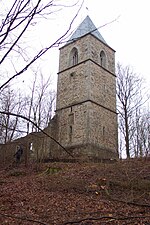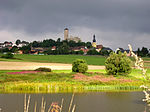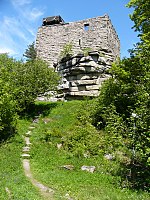With its 827-metre-high (2,713 ft) peak the Große Kornberg is the northeast cornerstone of the Fichtel Mountains in south Germany. It forms a wooded ridge, which is recognisable from a long distance by its former military surveillance tower It is also the local 'house' mountain of Schönwald and Schwarzenbach an der Saale.
Geologically, granite is the underlying rock. Its lower strata are grainy, but the upper layers contain fine-grained granite. Abandoned quarries are evidence of the ancient craft of stonemasons.
The oldest known document dates to 1317 and refers to the mountain as the Kurnberg. According to Professor Dr. Adolf Gütter, in Middle High German Kurn means 'mill', so it meant 'mill mountain'. On its northwest slopes there was once a village called Mühlhausen but it had been abandoned by the end of the 14th century.
The Kornberg itself lacks the imposing rock towers and felsenmeer terrain typical of other mountain peaks in the Fichtelgebirge. However, its secondary summit, the Hirschstein, has many steep, sometimes vertical, rock towers which made the location attractive to the medieval castle of the same name, of which now only a few remnants are left. Moreover, the mountain offers other attractions for the traveller: the Gypsy Rocks (Zigeunersteine) with its logan stone (Wackelstein), and the Schönburg Watchtower (Schönburgwarte) with its good views. In winter the lifts are used by skiers.









